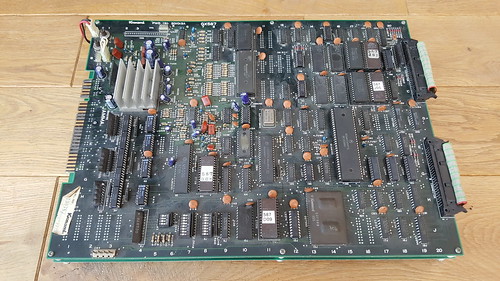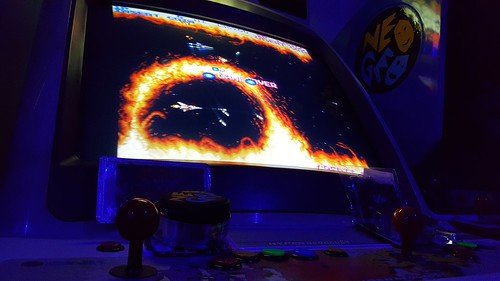I remember my school discos well. A can of Shandy or a carton of Tip Tops, a packet of crisps and change for the arcade machines was pure happiness! I first played Salamander at the annual school disco, probably not too long after its release. The game is a spin-off to Gradius and introduces a simplified power-up system, two-player cooperative gameplay and both horizontally and vertically scrolling stages. I remember the swirly fire dragons as I’ll call them, and the game being very hard. Twenty pence didn’t seem to get me very far on this game!
The venue was a pub in the village, The Kings Head. They had two generic cabs in the function room and one in the bar area. I think they were Electrocoin Goliaths, but my memory is hazy. In the function room they seemed to change out the least popular game each year. The cabs were always busy at the discos, and there was always a crowd round the cab featuring the new game. In addition to Salamander, I remember Empire City: 1931 (I think!) Final Fight and Shadow Warriors. I was blown away when I saw Final Fight here for the first time, and I remember watching someone clear Shadow Warriors and the excitement as Ryu Hayabusa defeats the boss and sails back to Tokyo in his boat.
 |
| The King’s Head during April 2020 during the lockdown. Unfortunately the arcade cabs are long gone! |
I didn’t get to play the machine in the bar area very often, only playing it when my parents decided to go there for a drink. The only game I remember playing in the bar was Capcom’s awesome Magic Sword.
Going back to Salamander, the game has an interesting history. The arcade version was released under its original title in Japan (version J) and as Life Force in North America. The Japanese and European versions are nearly identical, but the American version changes the game’s plot by setting the game inside a giant alien life form, infected by a strain of bacteria. Stages featuring star field backgrounds were altered to reflect this, and the power-ups were given different names. An enhanced version of Salamander was later released in Japan, with the American title Life Force. The theme was extended, with the backgrounds and mechanical enemies being completely redrawn and given organic appearances. Also the power-up system was modified, using the same system as Gradius and some of the music tracks have been completely changed.
It’s also cool to note that Electrocoin released a dedicated cab, complete with awesome artwork. These are pretty rare now, and I’ve only seen a few come up over the years.
On my most recent Raid I picked up a Salamander board. I was really happy to find one, and it was definitely one of the highlights. However the boards had been stored poorly, and I didn’t expect it to work. Upon testing, the game booted to garbage and required extensive repair work. VectorGlow has once again worked his magic. Repair work was time consuming, with him replacing nineteen logic chips and all of the optocouplers, two EPROMs, the main 68000 CPU and a capacitor. These were all on the top board, there were no faults on the lower board. The board is version J.
The Hyper Neo is my cab of choice for this board.
I love how much room there is inside the cab, and I recently had a shelf made to fully utilise the space.








No comments:
Post a Comment